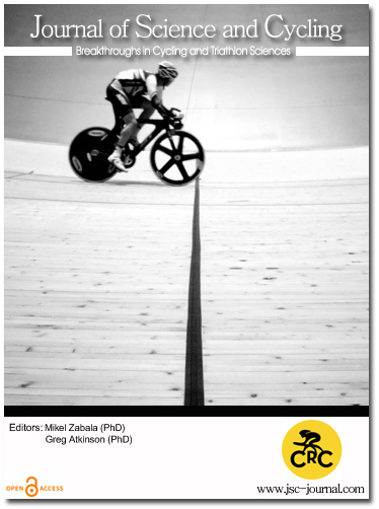A new test battery to assess bike handling skills of experienced and inexperienced cyclists
Abstract
Background: Bike handling skills aimed to maintain balance are important to prevent falling off the bike and/or crashing into obstacles. Past research on dynamics and control of bicycles is inconclusive on how human balance during cycling and how they control trajectories and direction during cycling (Moore et al., 2011, Proceedings of the ASME 2009 International Design and Engineering Technical Conferences & Computers and Information in Engineering Conference, 1-20). Purpose: Our aim was to develop a valid and reliable test to discriminate between good and poor bike handling skills. Additionally, we were interested how the motor control mechanisms during cycling differ between expert and novice cyclists. We hypothesised that 1) cycling deviation amplitude will reliably show differences between novices and experts and 2) experts will perform smoother and smaller steering corrections compared to the novices.Methods: 14 experienced cyclists (riding over 2000 km per year) 14 inexperienced cyclists (riding a bike less than 100 km per year) volunteered to ride a commuting bike in the lab for 7 metres under three different conditions: in the centre of the lane with flying and standing start, and following a line with a flying start. We measured deviation from the centre of the lane or line, steering and leaning (Vicon system). Two-way mixed ANOVA (condition (3) x group (2)) was applied to test for differences between the groups. Inter-session reliability was assessed with reliability test using Cronbach alpha.
Results: Deviation was found to be very reliable with Cronbach’s alpha values higher than 0.75. There was a statistically significant difference between the groups for lateral deviation range (F(1,26) = 11.373; p = 0.002) and standard deviation (F(1,26) = 10.268; p = 0.004). We observed a statistically significant between-group difference for steering range (F(1,26) = 12.034; p = 0.002), steering standard deviation (F(1,26) = 10.211; p = 0.004) and leaning standard deviation (F(1,26) = 5.219; p = 0.031). No statistically significant difference was present for leaning range (F(1,26 = 1.498; p = 0.232).
Discussion: The results support the first hypothesis by showing that the test used in this study is sensitive to detect differences between novice and expert cyclists and can be used for further research that aims to test the effect of a specific intervention (e.g. training) on bike handling. We also showed that the main motions, which were described before as the main motor control actions in bike handling differ between the novice and expert cyclists in the variability and amplitude. The results of the present study have implications for training designs.
Conclusion: Cycling in a straight line is a valid and sensitive test to evaluate the level of bike handling skills. Inexperienced cyclists control the bike using the same motor control actions as experts, but with an increased variability.
Downloads
Published
How to Cite
Issue
Section
Copyright (c) 2014 Journal of Science and Cycling

This work is licensed under a Creative Commons Attribution-NonCommercial 4.0 International License.
Authors contributing to Journal of Science and Cycling agree to publish their articles under a Creative Commons CC BY-NC-ND license, allowing third parties to copy and redistribute the material in any medium or format, and to remix, transform, and build upon the material, for any purpose, even commercially, under the condition that appropriate credit is given, that a link to the license is provided, and that you indicate if changes were made. You may do so in any reasonable manner, but not in any way that suggests the licensor endorses you or your use.
Authors retain copyright of their work, with first publication rights granted to Cycling Research Center.






